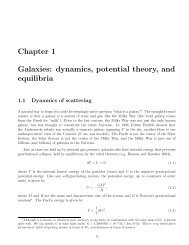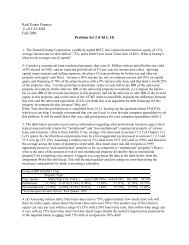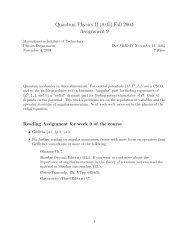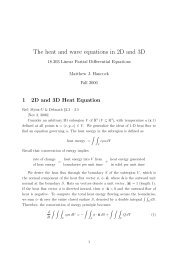Problem Set 7 12.742 Answer Key 1.a) U is conservative in ...
Problem Set 7 12.742 Answer Key 1.a) U is conservative in ...
Problem Set 7 12.742 Answer Key 1.a) U is conservative in ...
Create successful ePaper yourself
Turn your PDF publications into a flip-book with our unique Google optimized e-Paper software.
<strong>Problem</strong> <strong>Set</strong> 7 <strong>12.742</strong> <strong>Answer</strong> <strong>Key</strong><br />
<strong>1.a</strong>)<br />
234 U <strong>is</strong> <strong>conservative</strong> <strong>in</strong> seawater we can calculate the expected flux of 230 Th at any<br />
depth based solely on our knowledge of the decay rate of 234 U and the depth of the water.<br />
At steady state the production rate of 230 Th must equal its loss rate. The production rate<br />
<strong>is</strong> equal to the decay of 234 U (or its activity), and the loss <strong>is</strong> equal to decay of 230 Th and<br />
the scaveng<strong>in</strong>g rate. The decay rate of 230 Th <strong>is</strong> much slower than the scaveng<strong>in</strong>g rate,<br />
therefore for 230 Th production equals scaveng<strong>in</strong>g, and the flux <strong>is</strong> simply equal to the<br />
depth times the production rate:<br />
Production = 234 A U<br />
=1.14 ∗ 238 A U<br />
( )<br />
Loss : 230 Th ∗ λ 230<br />
+ 230 Th∗ k scav<br />
= 230 Th λ 230<br />
+ k scav<br />
λ 230<br />
>decay,<br />
Production=Scaveng<strong>in</strong>g). Th<strong>is</strong> <strong>is</strong> aga<strong>in</strong> true for any model.
<strong>Problem</strong> <strong>Set</strong> 7 <strong>12.742</strong> <strong>Answer</strong> <strong>Key</strong><br />
Production Rate ∗ z<br />
[ particles]= ω<br />
ω = 1.14 ∗238 A U<br />
∗ λ 230<br />
∗z<br />
particles [ ]<br />
⎛<br />
ω⎜<br />
⎝<br />
m ⎞<br />
⎟ = 1.14 ∗2400dpm ∗ 9.24 ×10 −6 y −1 ∗ z<br />
m 3<br />
y⎠<br />
⎛<br />
[ particles] ⎜ dpm ⎞<br />
⎟<br />
⎝ m 3 ⎠<br />
⎛<br />
ω⎜<br />
⎝<br />
m ⎞ ⎛<br />
⎟ = 0.0253<br />
y<br />
dpm ⎞<br />
⎜<br />
⎠ ⎝ m 3 ⎟ ∗<br />
⋅ y⎠<br />
z<br />
particles<br />
⎛<br />
⎜<br />
[ ] ⎝<br />
m4 dpm<br />
To make sure that we get an accurate s<strong>in</strong>k<strong>in</strong>g rate (ω) let’s calculate the s<strong>in</strong>k<strong>in</strong>g rate a<br />
few different locations. One th<strong>in</strong>g I’ll po<strong>in</strong>t out here <strong>is</strong> when convert<strong>in</strong>g the particle<br />
concentrations from dpm/kg to dpm/m 3 we are talk<strong>in</strong>g about the density of 230 Th particles<br />
<strong>in</strong> the water column. Not the density of what <strong>is</strong> caught <strong>in</strong> the trap. We can pull th<strong>is</strong><br />
<strong>in</strong>formation of the total small particle concentration graph, then convert to dpm/m 3 us<strong>in</strong>g<br />
the trap <strong>in</strong>formation. Th<strong>is</strong> makes a huge difference! I’ve done the calculations <strong>in</strong> the<br />
excel spreadsheet. You can see that the s<strong>in</strong>k<strong>in</strong>g rate ranges from 42m/y at 300m to<br />
500m/y at 3700m. Then it drops lower <strong>in</strong> the deepest samples. Why <strong>is</strong> th<strong>is</strong>? Well, if we<br />
th<strong>in</strong>k about how 230 Th works it <strong>is</strong> really a deep water scaveng<strong>in</strong>g <strong>is</strong>otope – so it <strong>is</strong>n’t good<br />
for the upper water column. So, let’s not use the samples shallower than 1000 m. Then<br />
we have the deepest samples. All the Th that has been scavenged out of the ocean<br />
eventually ends up <strong>in</strong> the sediments, and can get stirred back up <strong>in</strong>to the bottom waters.<br />
So let’s not bother with the samples from the lowest depths (4500 and deeper) that are<br />
clearly <strong>in</strong>fluenced by the bottom. So we are left with the middle samples, and they have<br />
an average s<strong>in</strong>k<strong>in</strong>g rate of about 325 m/y.<br />
1.b) To estimate the forward and backward scaveng<strong>in</strong>g rates (k 1 and k -1 , respectively)<br />
we must use two <strong>is</strong>otopes. 230 Th and 228 Th are both affected by the same scaveng<strong>in</strong>g<br />
rates, because they are the same species, chemically. They are different only <strong>in</strong> terms of<br />
their decay constants. Therefore, we can set up scaveng<strong>in</strong>g equations for both <strong>is</strong>otopes<br />
that conta<strong>in</strong> k 1 and k -1 as the unknowns, and by comb<strong>in</strong><strong>in</strong>g the two equations solve for<br />
each of the constants. To start, set up the equations and solve each for k 1 :<br />
⎞<br />
⎟<br />
⎠
<strong>Problem</strong> <strong>Set</strong> 7 <strong>12.742</strong> <strong>Answer</strong> <strong>Key</strong><br />
Now, solve for k -1 :<br />
A 230 ( k<br />
Th(d) 1<br />
+ λ 230 )= P + k 230<br />
Th −1A 230<br />
Th(p)<br />
k 1<br />
>>> λ 230<br />
A 230<br />
Th(d) k 1<br />
= P 230<br />
Th + k −1A 230<br />
Th(p)<br />
k 1<br />
= P 230 Th + k −1A 230<br />
Th(p)<br />
A 230<br />
Th(d)<br />
A 228 ( k<br />
Th(d) 1<br />
+ λ 228 )= P + k 228<br />
Th −1A 228<br />
Th(p)<br />
k 1<br />
= P 228 Th + k −1A 228<br />
Th(p) − λ 228A 228<br />
Th(d)<br />
A 228<br />
Th(d)<br />
P 230<br />
Th<br />
A 230<br />
Th(d)<br />
+ k −1A 230<br />
Th(p)<br />
A 230<br />
Th(d)<br />
= P228 Th<br />
+ k −1A 228<br />
Th(p)<br />
− λ 228<br />
A 228 A<br />
Th(d)<br />
228<br />
Th(d)<br />
k −1<br />
A 230<br />
Th(p)<br />
A 230<br />
Th(d)<br />
− k −1A 228<br />
Th(p)<br />
A 228<br />
Th(d)<br />
= P228 Th<br />
− λ 228<br />
− P230 Th<br />
A 228 A<br />
Th(d)<br />
230<br />
Th(d)<br />
P 228<br />
Th<br />
A 228<br />
Th(d)<br />
k −1<br />
=<br />
− λ 228<br />
− P 230 Th<br />
A 230<br />
Th(d)<br />
A 230<br />
Th(p)<br />
A 230<br />
Th(d)<br />
− A 228 Th(p)<br />
A 228<br />
Th(d)<br />
Now, all we need to know are the activities of the def<strong>in</strong>ed species (from the table) and<br />
calculate the production rate of 228 Th (just like for 230 Th, but we us<strong>in</strong>g 228 Ra (d) as its<br />
parent). Th<strong>is</strong> <strong>is</strong> all calculated <strong>in</strong> the excel spreadsheet. To calculate k 1 we just plug and<br />
chug our value of k -1 <strong>in</strong>to the above equation(s). Aga<strong>in</strong>, th<strong>is</strong> <strong>is</strong> done <strong>in</strong> the excel<br />
spreadsheet. The answers are dependant upon which depths you use (as you can see from<br />
the spreadsheet), and I haven’t graded based on your numerical answer, rather on your<br />
methodology.<br />
1.c) Now we are deal<strong>in</strong>g with a system where the Th <strong>is</strong> scavenged onto small particles,<br />
but then the small particles aggregate <strong>in</strong>to large particles, and only the large particles<br />
s<strong>in</strong>k. Our equations are set just as they were previously, with production equal<strong>in</strong>g loss:
<strong>Problem</strong> <strong>Set</strong> 7 <strong>12.742</strong> <strong>Answer</strong> <strong>Key</strong><br />
Production = Loss<br />
dA D<br />
dt<br />
dA S<br />
dt<br />
= λ D<br />
A P<br />
− λA D<br />
− k 1<br />
A D<br />
+ k −1<br />
A S<br />
+ β −1<br />
A S<br />
= k 1<br />
A D<br />
+ β −2<br />
A L<br />
− k −1<br />
A S<br />
− β −1<br />
A S<br />
− β 2<br />
A S<br />
− λA S<br />
dA L<br />
dt<br />
= β 2<br />
A S<br />
− β −2<br />
A L<br />
− λA L<br />
−ω ∂A L<br />
∂z<br />
steady state : dA<br />
dt = 0<br />
λ D<br />
A P<br />
+ ( k −1<br />
+ β −1 )A S<br />
= ( λ + k 1 )A D<br />
k 1<br />
A D<br />
+ β −2<br />
A L<br />
= ( k −1<br />
+ β −1<br />
+ β 2<br />
+ λ)A S<br />
β 2<br />
A S<br />
= ( β −2<br />
+ λ)A L<br />
+ ω ∂A L<br />
∂z<br />
1.d) If β 2 and β- 2 are 3 y -1 and 150 y -1 , respectively, then particles must d<strong>is</strong>aggregate<br />
much faster than they aggregate. Th<strong>is</strong> <strong>in</strong>dicates that at any moment most of the particles<br />
are <strong>in</strong> the small form. By know<strong>in</strong>g these two values we are able to calculate the particle<br />
s<strong>in</strong>k<strong>in</strong>g rate, and thus the removal of organic matter from the ocean:<br />
β 2<br />
A S<br />
= ( β −2<br />
+ λ)A L<br />
+ ω ∂A L<br />
∂z<br />
ω = β A − β 2 S ( + λ −2 )A L<br />
∂A L<br />
∂z<br />
To understand how th<strong>is</strong> affects OM cycl<strong>in</strong>g let’s simplify and say that new production <strong>is</strong><br />
primarily fueled by the replen<strong>is</strong>h<strong>in</strong>g of nutrients through upwell<strong>in</strong>g of nutrient-rich deep<br />
water. Deep water nutrient concentrations are dependant upon the rem<strong>in</strong>eralization of<br />
s<strong>in</strong>k<strong>in</strong>g organic matter, and th<strong>is</strong> <strong>is</strong> dependant on the aggregation/d<strong>is</strong>aggregation rates of<br />
particles. Thus, on some long time scales, new production <strong>is</strong> dependant on the<br />
aggregation/d<strong>is</strong>aggregation rates of particles.<br />
2.a) Th<strong>is</strong> <strong>is</strong> another Th problem! Why so many Th problems? Because it an<br />
extremely useful element for measur<strong>in</strong>g ocean processes, not only are its <strong>is</strong>otopes <strong>in</strong> U/Th<br />
decay series, but they are particle reactive, and the different <strong>is</strong>otopes have a large range<br />
of decay rates, allow<strong>in</strong>g us to measure lots of different time scales. In th<strong>is</strong> case we are<br />
compar<strong>in</strong>g the relatively long-lived <strong>is</strong>otopes of 230 Th (t 1/2 = 75000y) to another particle<br />
reactive <strong>is</strong>otope, 231 Pa. Th <strong>is</strong> more susceptible to scaveng<strong>in</strong>g (more particle reactive) than<br />
Pa, therefore Th has a shorter residence time <strong>in</strong> the water column. Consequently, Pa <strong>is</strong><br />
more likely to be affected by advection then Th, and more of it can then be removed from<br />
the central gyre regions to areas of high scaveng<strong>in</strong>g rates (like the cont<strong>in</strong>ental marg<strong>in</strong>s).<br />
By compar<strong>in</strong>g these two <strong>is</strong>otopes <strong>in</strong> sediment traps we can get a handle on how much of<br />
each <strong>is</strong> vertically scavenged, laterally advected, and how well the sediment traps do <strong>in</strong><br />
captur<strong>in</strong>g fall<strong>in</strong>g OM.
<strong>Problem</strong> <strong>Set</strong> 7 <strong>12.742</strong> <strong>Answer</strong> <strong>Key</strong><br />
First, we need to calculate the amount of scaveneged Th and Pa the traps<br />
collected. To do th<strong>is</strong> we need to take the amount of each <strong>in</strong> the trap and subtract off the<br />
amount of Th and Pa present <strong>in</strong> secular equilibrium with their parent <strong>is</strong>otopes ( 234 U and<br />
235 U, respectively). We do th<strong>is</strong> because we are only <strong>in</strong>terested <strong>in</strong> the ‘excess’ Th and Pa<br />
– the equilibrium Th and Pa trapped <strong>in</strong> the m<strong>in</strong>eral matrix came from the decay of U<br />
trapped <strong>in</strong> the matrix, and was never d<strong>is</strong>solved <strong>in</strong> the ocean, and therefore was never<br />
scavenged. For Th, th<strong>is</strong> <strong>is</strong> easy, 238 U <strong>is</strong> give to us, so:<br />
Scavenged 230 Th = 3.00 dpm g − 0.20dpm g = 2.80dpm g<br />
In th<strong>is</strong> case we can assume that 234 U and 238 U are <strong>in</strong> secular equilibrium. If you make the<br />
calculations (as below for 235 U) us<strong>in</strong>g the crustal abundance you will f<strong>in</strong>d that 234 U =<br />
1.01* 238 U = 1.01*0.20 = 0.20 (the same with<strong>in</strong> the significant figures we have available<br />
to us).<br />
To calculate the 235 U <strong>in</strong> the trap we use the known 235 U/ 238 U ratio and the decay<br />
constants. The ratios given <strong>in</strong> the HBCP are atom ratios – so you can’t just multiply by<br />
the activities! (Note: 238 U <strong>is</strong> essentially 1, which <strong>is</strong> why I only used 0.0072. It <strong>is</strong> more<br />
rigorous <strong>is</strong> to use 0.0072/0.99275, but the answer <strong>is</strong> the same.)<br />
235 U 238 = 0.0072 (by atoms)<br />
U 235 A<br />
238 A = ⎛ λ ⎞ ⎛<br />
235<br />
⎜ ⎟ N ⎞ ⎛<br />
235<br />
9.85 ×10−10 ⎞<br />
⎜ ⎟ = ⎜<br />
⎟ 0.0072 = 0.046<br />
⎝ ⎠ ⎝ ⎠ ⎝ 1.551×10 −10<br />
⎠<br />
λ 238<br />
N 238<br />
235 A = 0.046 ∗ 235 A = 0.046 ∗ 0.20 dpm g = 9.15 ×10−3 dpm g<br />
And now we can calculate the scavenged 231 Pa:<br />
Scavenged 231 Pa = 0.125 dpm g − 9.15 ×10−3 dpm g = 0.1158dpm g<br />
S<strong>in</strong>ce the trap was deployed for one year, the fluxes of 230 Th and 231 Pa:<br />
Scavenged Flux = Amount Scavenged dpm 10.2<br />
⎛<br />
⎜<br />
⎞<br />
g ⎟<br />
y<br />
⎝ g<br />
×<br />
⎠ 0.5 m 2<br />
Scavenged Flux ( 230 Th) = 2.80 dpm g × 10.2 g y<br />
0.5 m 2 ≅ 57.1 dpm m 2 ⋅ y<br />
Scavenged Flux ( 231 Pa) = 0.1158 dpm g × 10.2 g y<br />
0.5 m 2 ≅ 2.36 dpm m 2 ⋅ y<br />
2.b)<br />
There are 4 equations that we can use to solve th<strong>is</strong> problem:
<strong>Problem</strong> <strong>Set</strong> 7 <strong>12.742</strong> <strong>Answer</strong> <strong>Key</strong><br />
P Th<br />
=V Th<br />
+H Th<br />
P Pa<br />
=V Pa<br />
+H Pa<br />
R V<br />
= V Th<br />
V Pa<br />
R H<br />
= H Th<br />
H Pa<br />
These equations are comb<strong>in</strong>ed to solve for the vertical fluxes as follows:<br />
(<br />
V Th<br />
= P Th<br />
-R H<br />
⋅ P Pa )R V<br />
R V<br />
− R H<br />
( )<br />
V Pa<br />
= P Th<br />
-R H<br />
⋅ P Pa<br />
R V<br />
− R H<br />
R H<br />
= 2<br />
R V<br />
= V Th<br />
V Pa<br />
= 57<br />
2.36 ≈ 24<br />
P Th<br />
= λ 230<br />
∗ A 234<br />
U = 9.22 ×10−6 y −1 ∗2.75 dpm L 103 L<br />
m<br />
3<br />
( ) = 2.52 ×10−2 dpm m 3 y<br />
P Pa<br />
= λ 231<br />
∗ A = 2.13 235<br />
U ×10−5 y −1 ∗0.108 dpm L 103 L<br />
( m<br />
3) = 2.30 dpm ×10−3 m 3 y<br />
⎛<br />
2.52 ×10 −2 dpm m 3 y − 2⋅ 2.30 dpm ⎞<br />
⎜<br />
×10−3 m 3 ⎟ ∗24<br />
⎝<br />
y⎠<br />
V Th<br />
=<br />
= 2.25 ×10 −2 dpm 24 − 2<br />
m 3 y<br />
⎛<br />
2.52 ×10 −2 dpm m 3 y − 2 ⋅ 2.30 dpm ⎞<br />
⎜<br />
×10−3 m 3 ⎟<br />
⎝<br />
y⎠<br />
V Pa<br />
=<br />
= 9.36 ×10 −4 dpm 24 − 2<br />
m 3 y<br />
The production (P) of thorium and protact<strong>in</strong>ium <strong>is</strong> not a flux – it <strong>is</strong> a concentration per<br />
unit time. You then need to use the depth of the trap to determ<strong>in</strong>e the V values, but the P<br />
values are technically not fluxes. It works out ok here, because th<strong>in</strong>gs cancel, but <strong>in</strong><br />
many other cases you do not want to multiply by depth unless you are calculat<strong>in</strong>g a flux.<br />
The fraction of each <strong>is</strong>otope removed by vertical flux and the fraction removed by lateral<br />
transport are as follows:
<strong>Problem</strong> <strong>Set</strong> 7 <strong>12.742</strong> <strong>Answer</strong> <strong>Key</strong><br />
f 230<br />
= V 2.25 ×10 −2 dpm<br />
Th<br />
m 3 y<br />
=<br />
P Th 2.52 ×10 −2 dpm = 0.89<br />
m 3 y<br />
f 231<br />
= V 9.36 ×10 −4 dpm<br />
Pa<br />
m 3 y<br />
=<br />
P Pa 2.33×10 −3 dpm = 0.40<br />
m 3 y<br />
The Th removal by vertical flux <strong>is</strong> 89% and by lateral <strong>is</strong> 11%. The Pa removal by<br />
vertical flux <strong>is</strong> 40% and by lateral <strong>is</strong> 60%.<br />
2.c)<br />
The trapp<strong>in</strong>g efficiency of the sediment trap <strong>is</strong> calculated as:<br />
E= F V<br />
Flux from sediment trap<br />
F=<br />
depth of sediment trap<br />
E Th<br />
= F 57.1<br />
Th<br />
= 3000 = 0.84<br />
−2<br />
V Th<br />
2.24 ×10<br />
E Pa<br />
= F 2.36<br />
Pa<br />
= 3000 = 0.84<br />
−4<br />
V Pa<br />
9.33×10<br />
S<strong>in</strong>ce the trap <strong>is</strong> collects 84% of the vertical flux, then we know that the actual amount of<br />
material fall<strong>in</strong>g at 3000 m <strong>is</strong>:<br />
Flux collected <strong>in</strong> trap = Acutal Flux∗ Trapp<strong>in</strong>g Efficiency<br />
10.2 g y<br />
Actual Flux = ÷ 0.84 ≅ 24 g 0.5 m 2 y⋅ m 2<br />
3.a) DIC <strong>in</strong>creases as a water mass ages, both from the rem<strong>in</strong>eralization of OM and<br />
the d<strong>is</strong>solution of calcium carbonate. These two process differ <strong>in</strong> that rem<strong>in</strong>eralization<br />
typically requires the consumption of O 2 (except <strong>in</strong> anoxic water parcels) and d<strong>is</strong>solution<br />
of CaCO 3 does not. Also, CaCO 3 d<strong>is</strong>solution <strong>in</strong>creases the alkal<strong>in</strong>ity of the water parcel,<br />
and OM rem<strong>in</strong>eralization does not. These differences allows us calculate the DIC from<br />
rem<strong>in</strong>eralization of OM and from the d<strong>is</strong>solution of CaCO 3 .<br />
The Apparent Oxygen Utilization (AOU) <strong>is</strong> used with the Normal Atmospheric<br />
Equilibrium Concentration (NAEC) to stoichiometrically calculate the OC rem<strong>in</strong>eralized:
<strong>Problem</strong> <strong>Set</strong> 7 <strong>12.742</strong> <strong>Answer</strong> <strong>Key</strong><br />
AOU = NAEC - [ O 2 ] <strong>in</strong> situ<br />
AOU = 331.8 μmol kg − 250μmol kg = 81.8μmol kg<br />
⎛<br />
OC rem<strong>in</strong>. = AOU × C ⎞<br />
⎜ ⎟<br />
⎝ O 2 ⎠<br />
Redfield<br />
OC rem<strong>in</strong>.= 81.8 μmol kg × ⎛ 117 ⎞<br />
⎜ ⎟ ≈ 56 μmol ⎝ 170⎠<br />
kg<br />
To calculate the number of moles of CaCO 3 rem<strong>in</strong>eralized we can use the<br />
relationship between CaCO 3 d<strong>is</strong>solution and alkal<strong>in</strong>ity: for 1 mole of CO 3 2- added to the<br />
water from CaCO 3 , 2 moles of alkal<strong>in</strong>ity are added.<br />
CaCO 3<br />
d<strong>is</strong>solved = 1 2 ( CA meas<br />
-CA pref )<br />
CA = [HCO 3 - ] +2[CO 3 2- ]<br />
TA = [HCO 3 - ] +2[CO 3 2- ] +[OH - ] +[B(OH) 4 - ] -[H + ] +m<strong>in</strong>or species<br />
( )<br />
CA pref<br />
= TA pref<br />
− [OH - ] +[B(OH) 4 - ] -[H + ]<br />
pH = 8.2, S = 35‰ :<br />
TA pref<br />
= 547.05 + ( 50.56 × S)= 2316.7 μmol kg<br />
[H + ]=10 -8.2 mol kg<br />
[OH - ]=10 -5.8 mol kg<br />
[B(OH) 4 - ] = K B<br />
∗11.9 ×10 −6 ∗ S<br />
K B<br />
+ [H + ]<br />
= 10−8.91 ⋅10 −8.91 ⋅ 35<br />
10 −8.91 +10 −8.2 = 66.1 μmol kg<br />
CA pref<br />
= 2316.7 μmol kg −10-5.8 mol kg<br />
− 66.1 μmol kg +10-8.2 mol kg<br />
= 2249 μmol kg<br />
CaCO 3<br />
d<strong>is</strong>solved = 1 ⎛<br />
⎜ 2<br />
2300 μmol ⎝ kg − 2249μmol ⎞<br />
⎟<br />
kg<br />
≈ 25 μmol ⎠ kg<br />
3.b) To calculate the preformed nutrient we use the AOU and Redfield ratios to<br />
determ<strong>in</strong>e the nutrients produced through OM rem<strong>in</strong>eralization, and then subtract those<br />
numbers from the measured (<strong>in</strong> situ) concentrations. For DIC we do basically the same<br />
th<strong>in</strong>g, but we also have to account for the DIC added dur<strong>in</strong>g CaCO 3 d<strong>is</strong>solution.
<strong>Problem</strong> <strong>Set</strong> 7 <strong>12.742</strong> <strong>Answer</strong> <strong>Key</strong><br />
⎛<br />
NO - 3<br />
recycled = AOU × N ⎞<br />
⎜ ⎟<br />
⎝ O 2 ⎠<br />
Redfield<br />
NO - 3<br />
recycled = 81.8 μmol kg × ⎛ 16 ⎞<br />
⎜ ⎟ = 7.7 μmolN ⎝ 170⎠<br />
kg<br />
NO - 3<br />
preformed = 21.5 μmol kg − 7.7μmol kg =13.8μmol kg<br />
⎛<br />
PO 3- 4<br />
recycled = AOU × P ⎞<br />
⎜ ⎟<br />
⎝ O 2 ⎠<br />
Redfield<br />
PO 3- 4<br />
recycled = 81.8 μmol kg × ⎛ 1 ⎞<br />
⎜ ⎟ = 0.48 μmolP ⎝ 170⎠<br />
kg<br />
PO 3- 4<br />
preformed =1.45 μmol kg − 0.48μmol kg = 0.97μmol kg<br />
DIC preformed = DIC meas<br />
- DIC OM<br />
− DIC CaCO3<br />
DIC preformed = 2180 μmol kg − 56μmol kg − 25μmol kg ≈ 2100μmol kg<br />
3.c) The Ca 2+ added from CaCO 3 d<strong>is</strong>solution <strong>is</strong> only a small addition to the total Ca 2+<br />
present <strong>in</strong> seawater. Ca 2+ <strong>is</strong> <strong>conservative</strong> <strong>in</strong> seawater at ~10mmol/kg. Therefore, the<br />
<strong>in</strong>crease of 25µmol/kg only represents a change of ~0.25%.<br />
3.d) In order to use up the rema<strong>in</strong><strong>in</strong>g O 2 , the amount of OC we will need to<br />
rem<strong>in</strong>eralize will be (assum<strong>in</strong>g perfect Redfield stoichiometry):<br />
⎛ ⎞<br />
⎟<br />
⎝ 170⎠<br />
[ C org ]= ⎜<br />
117<br />
Redfield<br />
∗ 250 μmol O 2<br />
kg<br />
=172 μmol C org<br />
kg<br />
3.e) To deplete the rema<strong>in</strong><strong>in</strong>g nitrate we can do the same th<strong>in</strong>g. But before we start<br />
multiply<strong>in</strong>g by ratios – what <strong>is</strong> the rema<strong>in</strong><strong>in</strong>g NO - 3 ? It <strong>is</strong> very important to remember that<br />
the oxic rem<strong>in</strong>eralization of OM <strong>in</strong> part d also generated NO - 3 . How much?<br />
⎛ ⎞<br />
⎟<br />
⎝ 170⎠<br />
−<br />
[ NO 3 ] = 16<br />
added<br />
⎜<br />
Redfield<br />
∗ 250 μmol O 2<br />
kg<br />
= 23.5 μmol C org<br />
kg<br />
−<br />
−<br />
−<br />
[ NO 3 ] = NO 3 rema<strong>in</strong><strong>in</strong>g<br />
[ ] + NO 3 measured<br />
[ ] = 21.5 + 23.5 = 45 μmol<br />
added kg<br />
Now to determ<strong>in</strong>e the appropriate ratio for denitrification. We are only consider<strong>in</strong>g<br />
carbohydrates, so that certa<strong>in</strong>ly makes life easier. The equation we need to use will be:<br />
10CH 2 O + 8HNO 3 ⇔ 10CO 2 + 4N 2 + 14H 2 O<br />
⎛ 10 mol C⎞<br />
OC oxidized by denitrification = ⎜ ⎟ × 45 μmolN ⎝ 8 mol N ⎠ kg = 56.3μmolC kg
<strong>Problem</strong> <strong>Set</strong> 7 <strong>12.742</strong> <strong>Answer</strong> <strong>Key</strong><br />
However, we know that organic matter <strong>is</strong>, on average, more reduced than a simple<br />
carbohydrate. If the molecular formula <strong>is</strong> changed to CH 2.72 O to reflect th<strong>is</strong> we have the<br />
equation:<br />
10CH 2.72 O + 9.44HNO 3 ⇔ 10CO 2 + 4.72N 2 + 18.32H 2 O<br />
⎛ 10 mol C ⎞<br />
OC oxidized by denitrification = ⎜ ⎟ × 45 μmolN ⎝ 9.44 mol N⎠<br />
kg = 47.7μmolC kg<br />
The amount of OC required to deplete all the NO 3 - thus decreases. Th<strong>is</strong> shouldn’t be a<br />
surpr<strong>is</strong>e, s<strong>in</strong>ce the OC <strong>is</strong> more reduced each molecule requires more of the oxidant (<strong>in</strong><br />
th<strong>is</strong> case NO 3 - ) for full oxidation.<br />
COMMON ERRORS ON Q3:<br />
CA preformed = TA preformed<br />
Th<strong>is</strong> <strong>is</strong> a bad assumption <strong>in</strong> th<strong>is</strong> case! If we make th<strong>is</strong> assumption then CA pref ><br />
CA meas , <strong>in</strong>dicat<strong>in</strong>g CaCO 3 precipitation. Remember – th<strong>is</strong> water parcel <strong>is</strong> deep water –<br />
there <strong>is</strong> no CaCO 3 formation go<strong>in</strong>g on s<strong>in</strong>ce it has left the surface, and probably only<br />
d<strong>is</strong>solution (pH drops).<br />
DIC pref = DIC meas + DIC Corg + DIC CaCO3<br />
Th<strong>is</strong> statement <strong>is</strong> entirely false. To account for the rem<strong>in</strong>eralization of OC and<br />
the d<strong>is</strong>solution of CaCO 3 these terms must be subtracted from the measured<br />
concentration. (However, if you made the CA=TA error I did accept a +DIC CaCO3<br />
because it <strong>in</strong>correctly calculates to an subtraction of DIC from the preformed<br />
concentration.)<br />
The last question I read <strong>in</strong>correctly while grad<strong>in</strong>g, so there are some scribbles at the<br />
bottom of some of your pages. Sorry about that!

















